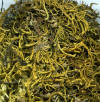|
References
-
Spjut, R.W., J. M. Cassady, T. McCloud, D. H. Norris,
M. Suffness, G. M. Cragg, and C. F. Edson. 1988. Variation in cytotoxicity and
antitumor activity among samples of a moss, Claopodium crispifolium (Hook.) Ren. & Card. (Thuidiaceae).
Economic Botany 42(1): 62-72.
-
Spjut, R. W., M. Suffness, G. M. Cragg, and D. H.
Norris. 1986. Mosses, liverworts and hornworts screened for antitumor
agents. Economic Botany 40: 310-338.
-
Suwanborirux, K., C.-J.
Chang, R. W. Spjut, and J. M. Cassady. 1990. Ansamitocin P-3, a
maytansinoid, from Claopodium crispifolium and Anomodon attenuatus
or associated actinomycetes.
Experientia 46:
117–120. While this paper suggests that the original activity in PS
may be due to a maytansinoid, the activity cannot be regarded as a random
occurrence. As indicated under another reference below, nine samples of
Claopodium crispifolium collected from logs, rocks, and trees at
scattered locations in California and Oregon by three different individuals,
working alone, during 1979, 1980, and 1981, were all active in PS and KB, as
also all samples of Anomodon attenuatus and A. rostratus.
The apparent significance of these moss species showing PS and KB
activity—reinforced by their taxonomic-biological activity
relationships—whether due to some symbiotic relationship with an actinomycete
(Nocardia?), or other association (Nostoc sp.), has yet to be
determined. See also Spjut et al, 1986,
Mosses, liverworts and
hornworts screened for antitumor agents, cited above, and Cassady et al.
(1990), Natural products as a source of potential chemotherapeutic and
chemopreventive agents, J. Nat. Prod. 53: 23–41.
http://pubs.acs.org/cgi-bin/abstract.cgi/jnprdf/1990/53/i01/f-pdf/f_np50067a003.pdf?sessid=6006l3.
Nevertheless, the occurrence of maytansinoids in mosses has also been reported
by Sakai, K., T. Hikawa, U. Amada, M. Yamashita, M. Animoto, A. Hikitay, A.
Uin, and K. Oksoin Do. 1988.
Antitumor principles in
mosses: The first isolation and identification of maytansinoids, including a
novel 15-methoxyansamitocin-P-3.
J.
Nat. Prod. 51: 845–850. The authors report a similar consistency in
finding activity in all six samples of Isothecium diversiforme from six
different locations in southern Japan.
-
USDA Memorandum, Spjut to POSI
(Plants of Special Interest) File, Claopodium crispifolium
(Hook.) R. & C. (Thuidiaceae), 16 July 1980.
-
USDA accession record
and shipping list for Claopodium crispifolium, PR-50973, SPJ-5447,
among other samples collected in April 1979, nine of which are shown on this one page; samples shipped to RALTECH, 18 May 1979.
-
Summary of screening
data for nine samples of Claopodium crispifolium, received
by R. Spjut from J. Cassady, undated, but had to have been sometime before
1987. The remarkable discovery here is the same screening results in PS
were found in two separate samples from the same general collection area,
Triangle Lake, Oregon, one sample from a single rock (SPJ-6644), the other
gathered from smaller rocks, rotting logs and bark of live trees (SPJ-6640).
The handwritten notations were added by R. Spjut to the typed page after it
was received from J. Cassady. These data were also incorporated into the
paper published in Economic Botany 1988, mentioned above.
-
Spjut, R. W., D. G. I.
Kingston, and J. M. Cassady. 1992. Systematic screening of bryophytes
for antitumor agents.
Tropical Bryology
6: 193–202. Includes a discussion on the recollection effort
made for Claopodium crispifolium as also summarized in the USDA
Memorandum by Spjut cited above.
|







